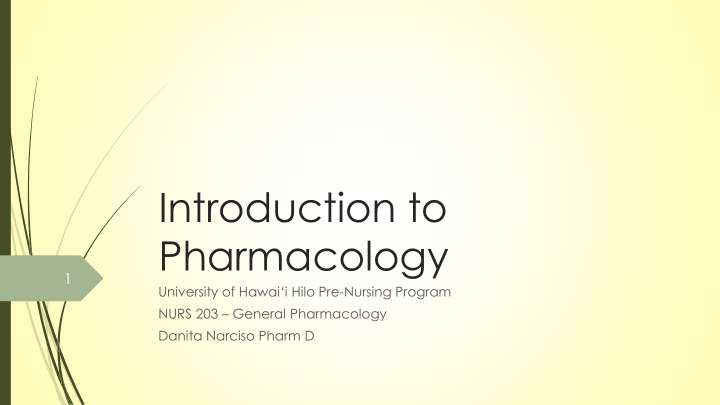



Introduction to Pharmacology 1 University of Hawai„i Hilo Pre -Nursing Program NURS 203 – General Pharmacology Danita Narciso Pharm D
Learning Objectives 2 Understand the barriers that drug molecules must overcome to complete a cycle from absorption to excretion in the body (tissue and membrane) Understand the different ways drug molecules transport across membranes Know the different characteristics of binding sites Know the different characteristics of bonds
Definitions 3 Pharmacology – The study of substances that interact with living systems through chemical processes. Medical pharmacology – The area of pharmacology concerned with the use of chemicals in the prevention, diagnosis, and treatment of disease, especially in humans. Toxicology – The area of pharmacology concerned with the undesirable effects of chemicals on biologic systems. Pharmacokinetics – Describes the effects of the body on drugs. Pharmacodynamics – Describes the effects of the drug on the body.
Types of drugs 4 Endogenous Produced in the body Hormones Neurotransmitters Exogenous Not produced in the body Poisons Drugs with almost only harmful effects Toxins Naturally occurring poisons
Breaking Through the Barriers 5 Many biological barriers Tissue Cell membranes
Tissue Barriers 6 A bsorption M etabolism Exiting the body Reaching the site of action (brain) Intestinal epithelium Brain capillaries Blood brain barrier Capillaries General circulation Liver Liver First pass effect (metabolism) General circulation Metabolism (biotransformation) General circulation Blood brain barrier Brain capillaries Kidney Brain tissue D istribution E xcretion
Cellular Transport – Cell Membrane 7 barriers Transcellular Passive diffusion Transporters Carrier mediated transport Facilitated diffusion Active transport Transcytosis Paracellular
Passive Diffusion 8 Diffusion – The natural tendency for molecules to move from an area of higher concentration to lower concentration *no energy required* Area of high Area of low Equilibrium concentration concentration
Passive Diffusion 9 Diffusion – The natural tendency for molecules to move from an area of higher concentration to lower concentration Hydrophilic Hydrophobic Water loving Water resistant Lipophobic Lipophilic
Passive Diffusion 10 Diffusion – The natural tendency for molecules to move from an area of higher concentration to lower concentration Water like environment Hydrophilic substances Lipophilic substances Hydrophilic channels Through the lipid bilayer Oil like environment
Passive Diffusion 11 Passive diffusion of Lipophilic substances Factors that alter Concentration gradient Surface area of the membrane Thickness of the membrane Charge Electric gradient Permeability Must be permeable to pass through a membrane
Transporters 12 Transporters Membrane proteins with one or more active sites that move molecules across membranes Can be selective or non-selective Exist in the kidney, liver, intestines, and other tissues Carrier mediated transport Affinity
Facilitated Diffusion 13 Facilitated diffusion – a carrier medicate process that occurs only when a concentration gradient exists *no energy required* Facilitated diffusion Factors Concentration gradient Transporter concentration Affinity Types Uniporter
Active Transport 14 Active transport processes are able to transport molecules against their concentration gradient. *require energy* Active transport Against the concentration gradient Requires energy Use of transporters Uniport Symport Antiport Drug efflux transporters Efflux proteins Multidrug efflux
Transcytosis 15 Transcytosis (vesicular transport) – is a process by which certain substances are transported across cell membranes by the use of vesicles. Endocytosis Pinocytosis Phagocytosis Exocytosis
Paracellular Transport 16 Paracellular transport – the passing of substances through an epithelial or endothelial membrane by the use of cell junctions Types of paracellular transport Through epithelial membranes Gap junctions Smaller than 1 nm in diameter Through capillaries 5-30 nm in diameter Blood-Brain barrier Tight junctions Other enzymatic barriers Filtration Driven by hydrostatic pressure Leaky capillaries 50 -100 nm in diameter
More Than 1 Way to Skin a Cat 17 Substances or molecules are able to transport through biological membranes by more than 1 transport mechanism
Break…. 18 May be a good time to take a break
Regulatory Proteins (Receptors) 19 Drugs must interact with the body in order to promote change Proteins that receive and pass on chemical messages Types of regulatory proteins Receptor proteins Ion channel proteins Enzymes Transporters Drugs are not the only substances that can bin to receptors
Receptor proteins 20 Receive and process chemical signals from outside the cell Example of drugs that target receptor proteins Zyrtec Alpha Blockers
Ion channel proteins 21 Ion channels control the passage of ions through a cell‟s membrane Example of drugs that target ion channels Calcium channel blockers Digoxin
Ion channel proteins 22 Ion channels control the passage of ions through a cell‟s membrane Example of drugs that target ion channels Calcium channel blockers Digoxin
Ion channel proteins 23 Ion channels control the passage of ions through a cell‟s membrane Example of drugs that target ion channels Calcium channel blockers Digoxin
Ion channel proteins 24 Ion channels control the passage of ions through a cell‟s membrane Example of drugs that target ion channels Calcium channel blockers Digoxin
Enzymes 25 An enzymes job is to catalyze biochemical and metabolic reactions Examples of enzymes Examples of drugs that bind to enzymes Prote ASE Synth ASE Celecoxib Transcript ASE Aspirin
Transporters 26 Transporters help to transport substances across a cells membrane Examples of drugs that target transporters Prozac Cocaine
Bonds 27 Drugs form bonds at the site of action Types of bonds Covalent Ionic Hydrogen bonds Hydrophobic interactions
Covalent Bonds 28 Covalent bonds – sharing of electrons Covalent bonds in pharmacology “Irreversible” Aspirin and cyclooxygenase
Ionic bonds 29 Ionic bonds - the transferring of electrons between two atoms Ionic bonds in pharmacology (AKA electrostatic bond) “Reversible” Lidocaine
Hydrogen bonds 30 Hydrogen bonds – A weak electrostatic bond Hydrogen bonds in pharmacology Lactulose
Hydrophobic bonds 31 Hydrophobic interactions – interactions driven by the tendency to avoid water Hydrophobic interactions in pharmacology Weak Flagyl
Questions 32
Recommend
More recommend